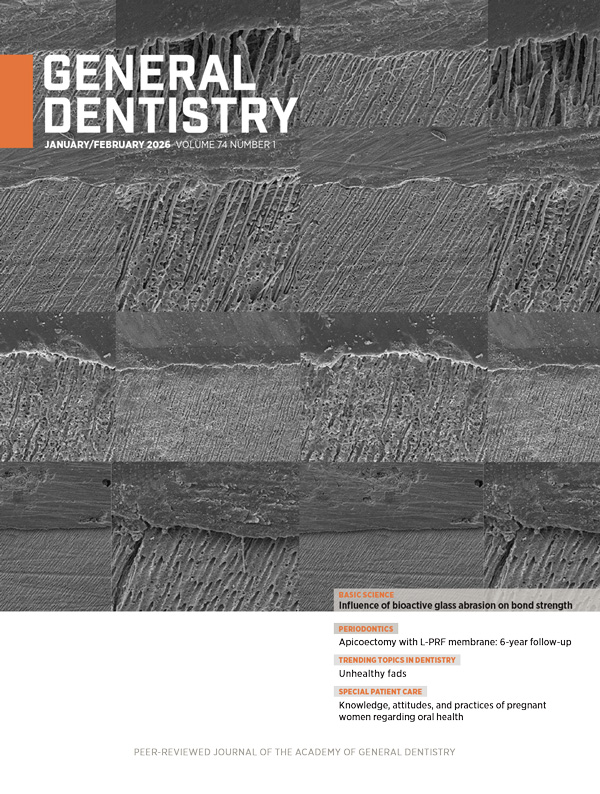
General Dentistry is the award-winning, peer-reviewed journal of the Academy of General Dentistry. Published bimonthly, General Dentistry features clinical articles spanning the breadth of topics relevant to general dentists, including unique diagnostic case reports, novel solutions to common treatment dilemmas, evidence-based best practices, and the science to help you choose the best materials, technology and procedures for your patients and your practice.
Table of Contents
Departments
-
Editorial Falling from the safety of the nest
Full Article (PDF)Timothy F. Kosinski2026 January/February; 74(1):5.
-
Pharmacology Ketorolac in dental pain management: a potent nonsteroidal anti-inflammatory drug with practical limits
Full Article (PDF)Jason H. GoodchildMark Donaldson2026 January/February; 74(1):6-9.
-
Implants Tooth replacement from extraction to restoration. 4. Restoration design and delivery
Full Article (PDF)Marcus Cowan
2026 January/February; 74(1):10-14.
-
Trending Topics in Dentistry Unhealthy fads
Full Article (PDF)John K. BrooksLisa C. D’AffronteNasir Bashirelahi2026 January/February; 74(1):16-18.
-
Oral Diagnosis Interradicular cystic radiolucency and Abnormal tooth morphology
Full Article (PDF)Galal Omami2026 January/February; 74(1):78,80.
-
Self-Instruction Answers Exercises No. GD539, GD540, and GD541
Full Article (PDF)2026 January/February; 74(1):79.
Clinical Articles
-
SELF-INSTRUCTION
Basic Science Comparing the shade stability of lithium disilicate veneers bonded with a light-curing or dual-curing resin cement: a narrative review
Full Article (PDF)Derek RejtoBen BaleviThis review assessed the color stability of lithium disilicate veneers bonded with light-curing vs dual-curing resin cement. A total of 10 studies with a moderate risk of bias met the inclusion criteria, and the majority of evidence found no significant difference in color stability between the 2 kinds of cement.2026 January/February; 74(1):20-26.
Self-Instruction Exercise No. GD555 -
SELF-INSTRUCTION
Endodontics Evidence-based approach to apexification: a literature review and novel clinical protocol
Full Article (PDF)Yale KimKishore ShettyThis article outlines a systematic procedure for achieving optimal outcomes of apexification and reviews the literature on materials typically used in apexification: calcium hydroxide, mineral trioxide aggregate, and Biodentine. Contemporary calcium silicate–based materials such as mineral trioxide aggregate and Biodentine offer improved outcomes compared with calcium hydroxide.2026 January/February; 74(1):28-33.
Self-Instruction Exercise No. GD556 -
SELF-INSTRUCTION
Periodontics Periapical scar formation after apicoectomy using leukocyte- and platelet-rich fibrin as sole filling material: a case report with 6-year follow-up
Full Article (PDF)Luiz Guilherme FiorinGabriela Carrara SimionatoOtávio Augusto Pacheco VitóriaRuan Henrique Delmonica BarraEster Oliveira SantosElisa Mara de Abreu FurquimJuliano Milanezi De AlmeidaAfter 2 unsuccessful nonsurgical endodontic treatments, a periapical lesion was successfully treated with apicoectomy and placement of leukocyte- and platelet–rich fibrin membranes as the sole filling material. Incomplete resolution of the lesion was demonstrated 6 years postsurgery, but the tooth remained in function, and the treatment was considered a clinical success.2026 January/February; 74(1):36-40.
Self-Instruction Exercise No. GD557 -
Oral Medicine, Oral Diagnosis, Oral Pathology Unusual incidental findings on panoramic radiography: a case series
Full Article (PDF)John K. BrooksAzin ParsaJeffery B. PriceInterpretation of panoramic radiographs requires a broad knowledge of normal anatomical structures, pathologic disorders, and a diverse array of anomalies. This report presents a series of 5 incidental findings rarely documented on panoramic radiography to increase awareness of unusual observations.2026 January/February; 74(1):42-46.
-
Special Patient Care Knowledge, attitudes, and practices of pregnant women regarding maternal and child oral health: questionnaire development, psychometric properties, and associated factors
Full Article (PDF)Mayara da Costa MottaGabriella Oliveira da Silva ClementeYuri Wanderley CavalcantiMariana Leonel MartinsAndréa Fonseca-GonçalvesA questionnaire was developed and applied to assess the knowledge, attitudes, and practices of pregnant women regarding maternal and child oral health. About 60% of participants demonstrated low knowledge, and having low knowledge was influenced by lower education level and multiparity. Participants who visited the dentist during pregnancy reported more positive attitudes and practices.2026 January/February; 74(1):47-54.
-
Basic Science Disinfection and bacterial extrusion in mesial canals of mandibular molars prepared with intentional foraminal enlargement: an in vitro study
Full Article (PDF)Letícia de AraújoKetillyn da Silva MagalhãesTaynara Santos GoulartBruna Venzke FischerBeatriz Serrato Coelho RossettoDaniela Peressoni Vieira-SchuldtRayssa Sabino-SilvaCleonice da Silveira TeixeiraEduardo Antunes BortoluzziLucas da Fonseca Roberti GarciaJosiane de AlmeidaTo assess the effects of intentional foraminal enlargement on the disinfection of and apical bacterial extrusion in mesial root canals, 60 mandibular molars were split into groups based on irrigation protocol and preparation limit. Passive ultrasonic irrigation with intentional foraminal enlargement promoted greater disinfection than passive ultrasonic irrigation without enlargement or conventional irrigation.2026 January/February; 74(1):55-61.
-
Oral Medicine, Oral Diagnosis, Oral Pathology Painful and partially erupted odontoma: a case report
Full Article (PDF)John K. BrooksPatricia K. McAuleyMuhammad J. QaziAhmed S. SultanOdontomas, aggregations of calcified tissues usually found within the jawbones, are referred to as erupted odontomas if found within the oral soft tissues. This case report describes diagnosis and treatment of a partially erupted odontoma associated with gingival pain and inflammation. Prompt surgical removal of erupted odontomas is recommended to decrease the risk of clinical complications.2026 January/February; 74(1):62-66.
-
Basic Science Influence of bioactive glass air abrasion on the bond strength of adhesive to caries-affected dentin
Full Article (PDF)Zahra FattahFereshteh ShafieiShiva SobhaniThis study investigated the effect of bioactive glass (BAG) air abrasion on the microshear bond strength (μSBS) between caries-affected dentin and a universal adhesive used in etch-and-rinse (E&R) or self-etching (SE) mode. The addition of BAG abrasion had no adverse effects on μSBS when the adhesive was used in E&R mode but significantly reduced the μSBS when the adhesive was used in SE mode.2026 January/February; 74(1):67-72.
-
Endodontics Recurrence of clinical symptoms in an endodontically treated tooth following COVID-19 vaccination: a case report
Full Article (PDF)Teng Kai OngThis report describes an unusual case in which clinical symptoms recurred in a recently endodontically treated tooth after the patient received COVID-19 vaccination. The tooth was tender to percussion, but there were no other adverse signs, and the pain resolved within a few days after use of a nonsteroidal anti-inflammatory drug. Imaging 2 years later revealed complete resolution of periapical radiolucency. It is speculated that acute inflammation resulting from the vaccination may have produced clinical symptoms, but no definitive cause-effect relationship can be established.2026 January/February; 74(1):73-76.

